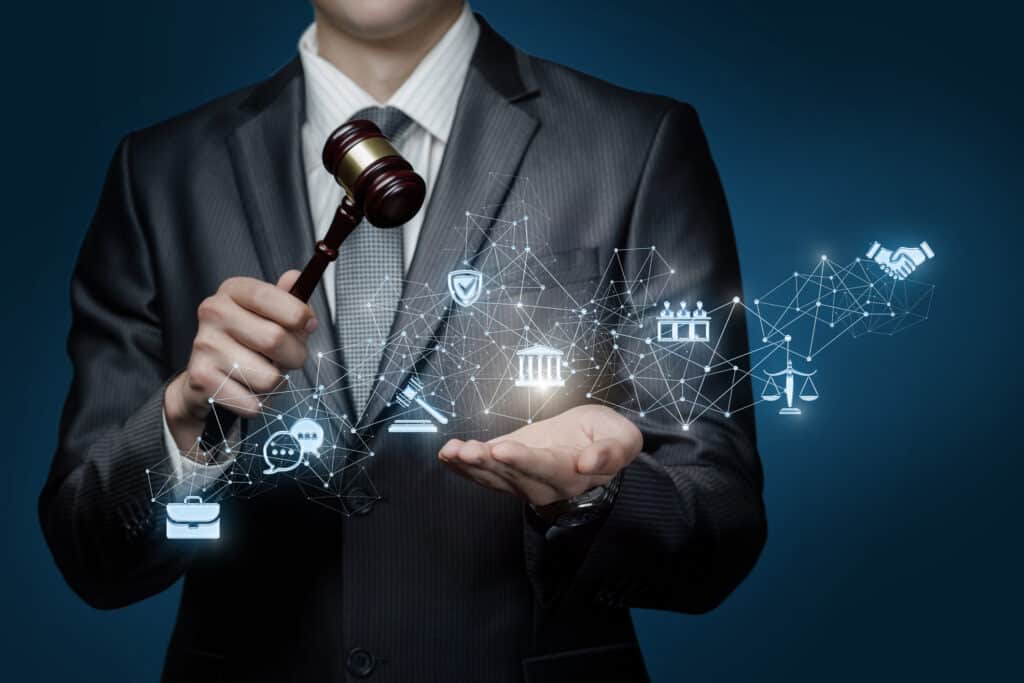Top Criminal Justice Technology for Lawyers

Criminal justice technology is a popular topic, thanks in part to television shows like CSI: Crime Scene Investigation. Unfortunately, Hollywood’s depiction of criminal justice tech, while exciting, only tells part of the story. Beyond flashy displays and digital crime scene recreations, there are also technology tools that help criminal defense lawyers provide better, more efficient representation.
Read on to learn what criminal justice technology is, why lawyers need to stay current on the latest tech developments, and which tools law enforcement and lawyers are using today to improve productivity and outcomes.
What Is Criminal Justice Technology?
Criminal justice technology refers to hardware and software applications that streamline the investigation and prevention of crime and the legal representation of criminal defendants. Those trends give law enforcement more tools to interpret crime scenes, identify crime patterns, and predict crime hotspots.
This is a fast-moving space that’s benefiting from broader technology innovations. Chipmakers are producing faster, more powerful processors, for example. At the same time, application developers are stretching the capabilities of artificial intelligence to collect and analyze data.
Prosecutors and defense lawyers also have more advanced tech resources at their disposal. The evolution of case management software is one example. These applications do far more than organize client records. They also house client communications and automate common tasks, both for the lawyer and the administrative staff.
Why Is Criminal Justice Technology Important for Lawyers?
Criminal defense lawyers who want to remain competitive must stay current with legal technology trends. At a minimum, deploying a cloud-based case management system facilitates more efficient representation by centralizing client files and making them accessible from anywhere.
Lawyers can also leverage technology in criminal justice to analyze evidence, locate specific details among vast amounts of data, research case law and statutes, collaborate with clients in different locations, and prepare compelling trial presentations.
Ultimately, the job of the defense lawyer is to find and present details that weaken or counter the prosecution’s case. The lawyer who leverages criminal justice technology can often fulfill that goal more efficiently than the lawyer who doesn’t.
Top 15 Criminal Justice Technology Tools
Another way to answer the question, what is criminal justice technology, is to highlight the specific tools in use today. Criminal justice tech is a broad field, encompassing several sub-disciplines. Four to watch are crime scene technology, secure document technology, communication tools, and case management technology. Below are 15 criminal justice technology tools, categorized by these four sub-disciplines.
Crime Scene Technology
Crime scene technology collects and analyzes data that investigators use to identify likely scenarios. Examples include crime scene cameras, 3D scanners, fingerprinting sensors and software, digital forensics tools, digital X-ray machines, DNA analysis systems, bullet trajectory software, and blood spatter analysis software.
- Crime scene cameras. Investigators use high-resolution digital cameras plus specialized lenses and lighting to document crime scenes. Trace evidence, such as cartridge case details, can be captured with macro lenses. Supplemental lighting in the form of lasers, blue light, green light, or oblique lighting may also be used to photograph footprints, bruises, and blood stains.
- 3D scanners. 3D scanners gather precise measurements of the crime scene, including relative locations of evidence such as blood spatter, bullet holes, fingerprints, and more. Using that data, investigators can recreate the scene digitally for analysis. The 3D map can then also be updated as new evidence surfaces.
- Fingerprinting sensors and software. Investigators use specialized sensors to digitize fingerprints found at crime scenes. A computer algorithm can then analyze the unique features of the digitized prints, and search fingerprint databases to find similar records. Any matches can either identify the print or link it to other crimes. Fingerprint databases include Automated Fingerprint Identification Systems (AFIS) used by law enforcement agencies and the FBI’s National Crime Information Center (NCIC).
- Digital forensics tools. Digital forensics is the investigation and use of digital evidence in court cases. Digital evidence is any data collected from computers, external hard drives, smartphones, and cloud storage accounts. Investigators use various hardware and software tools to recover and interpret digital evidence.
- Portable X-ray machines. Portable X-ray machines can provide visibility inside suspicious packages or objects without having to open them.
- DNA analysis systems. Investigators can recover DNA samples from the victim’s body or weapons and other objects found at the crime scene. Commonly, these are tiny samples that must be replicated via polymerase chain reaction or PCR. Once replicated, a lab can create a DNA profile. That profile can then be compared to information stored in the FBI’s Combined DNA Index System (CODIS). It can also be compared to the accused’s DNA to indicate guilt or innocence.
- Bullet trajectory software. 3D mapping software can include tools specifically for diagramming bullet routes. These routes in turn point to the position of the shooter. FARO Zone 3D is an example. The software uses entry and exit points from the crime scene to reconstruct the bullet’s probable line of travel.
- Blood splatter analysis software. Analysis of bloodstains can help investigators determine the relative positioning of victim and perpetrator at the time of injury. Software, like HemoSpat, can expedite this analysis by using a digital scene reconstruction to identify probable positioning and injury patterns.
Secure Document Technology
Secure document technology as it applies to criminal lawyers includes solutions designed to protect case-related documents. This includes email encryption, security measures on stored and shared files, and digital signature processes.
- Encrypted email. Information sent via unencrypted email can be intercepted by hackers. Encryption converts the email into a format that’s undecipherable by anyone but the intended recipient.
- Secure cloud storage. Cloud platforms enable file storage via the internet, vs. storing files on a physical hard drive located in the office. Documents stored in the cloud can be accessed from anywhere as long as the user has Wi-Fi and the appropriate permissions.
Cloud providers use various methods to protect stored documents and information from unauthorized access. Files and data can be encrypted. Systems can force users to establish and maintain complex passwords that are updated periodically. System administrators can also enable two factor authentication (2FA), which requires users complete two authentication steps to log in (in lieu of providing only a password).
- Secure file sharing platforms. Secure file sharing platforms use encryption to safeguard documents. Lawyers can use this technology to send evidence, court records, and other case files securely.
- Digital signatures. Attorneys often rely on digital signatures to execute service agreements. Digital signature technology uses cryptography to authenticate the signer and confirm that the document has not been altered.
Communication
Communication technologies in the criminal justice space include video conferencing and secure collaboration platforms lawyers use to consult with clients, experts, and other attorneys.
- Video conferencing. Video conferencing platforms like Zoom and Microsoft Teams became popular during the shelter-in-place era of the pandemic. Today, lawyers use these tools to have face-to-face conversations with clients and colleagues in other locations.
- Secure document collaboration. Lawyers use collaboration tools to share drafted documents securely with clients and gather feedback. Clients and co-counsels can mark up documents from separate locations without cumbersome check-in or versioning processes.
Case Management
Case management is an important area of criminal law software. An effective case management application streamlines lawyers’ daily workflows in several ways. Three examples are centralizing client records, supporting full text search so documents are easy to find, and integrating timekeeping for efficient invoice creation. MyCase, a full-featured case management and billing software, includes those three features plus several of the technologies outlined above.
- MyCase. MyCase is a robust cloud-based system that enables secure client communications plus document storage, sharing, and collaboration, and so much more. Security features include 128-bit SSL encryption for data transmission, 256-bit AES encryption for data storage, 2FA, user logins, and customizable user access permissions.
The MyCase Client Portal provides a centralized, secure location for all client communications. Within the portal, lawyers can exchange messages with clients, collaborate on documents, and even share billing information.
Clients can make online payments through the portal and upload documents. Any document upload by the client automatically triggers an alert to the lawyer.
The portal also includes a calendar and case activity feed, viewable by the client. Important dates and activities shared with the client populate automatically. The lawyer can also optionally upload documents to the case file without sharing them with the client.
Final Notes
Technology in criminal justice is continually evolving to streamline processes for investigators, law enforcement, and lawyers. There are tools to support the investigation of crime scenes, the sharing of documents and evidence, secure collaboration with clients and co-counsels, and efficient management of complex cases.
Outside of crime scene mapping and interpretation, MyCase incorporates many of these features. It’s a powerful case management software that addresses the entire client lifecycle, from the intake process through billing, adjudication, and resolution.
Sign up for a 10-day free trial or schedule a MyCase demo today to learn how MyCase can improve productivity at your law firm. We offer affordable monthly and yearly subscriptions. Plus, no commitment or credit card is required, and you can cancel anytime.






